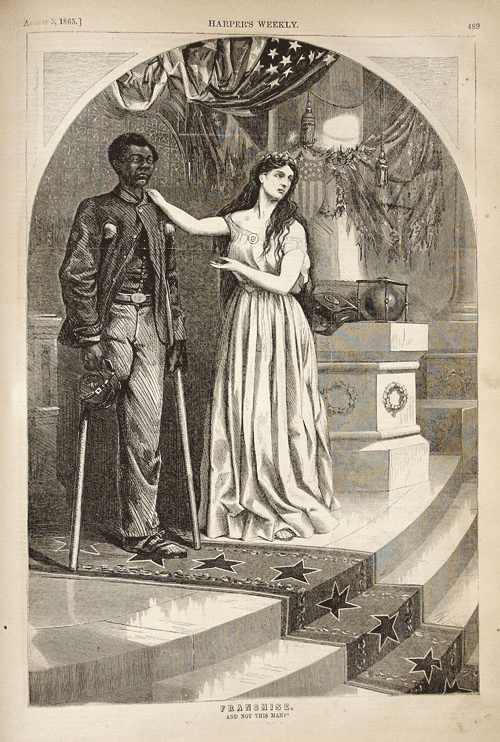After Appomattox: Military Occupation and the Ends of War by Gregory P. Downs. Harvard University Press, 2015. Cloth, ISBN: 978-0674743984. $32.95.
 When exactly did the Civil War end? This seemingly simple and straightforward question turns out to be much more complex and fascinating in Gregory P. Downs’s new book on Reconstruction and the military occupation of the South. Most people, if pressed to answer this question, would likely say that it was Robert E. Lee’s surrender at Appomattox that ended the war. More knowledgeable students of the Civil War might interject that it was the surrender of General Kirby Smith’s army in Texas in late May 1865 that finally put an end to the conflict. But Downs reminds us that the cessation of battlefield fighting or the dissolving of the Confederate army did not mean peace. Rather, a state of war continued for another six years.
When exactly did the Civil War end? This seemingly simple and straightforward question turns out to be much more complex and fascinating in Gregory P. Downs’s new book on Reconstruction and the military occupation of the South. Most people, if pressed to answer this question, would likely say that it was Robert E. Lee’s surrender at Appomattox that ended the war. More knowledgeable students of the Civil War might interject that it was the surrender of General Kirby Smith’s army in Texas in late May 1865 that finally put an end to the conflict. But Downs reminds us that the cessation of battlefield fighting or the dissolving of the Confederate army did not mean peace. Rather, a state of war continued for another six years.
In this fresh and deeply researched history of war powers and Reconstruction, Downs makes an important distinction between wartime and peacetime. The continuation of wartime, through presidential and congressional action, gave the federal government additional authority to reshape southern society and protect freedpeople. Where other historians have seen mostly discord and factionalism in the origins of Reconstruction, Downs shows that there was broad agreement among military leaders and Republican congressmen to extend war powers. Even President Andrew Johnson, who is often portrayed as a bitter opponent of military Reconstruction, saw the value almost immediately of retaining the power to suspend habeas corpus, declare martial law, and remove elected officials.
Soon after Lee’s surrender, the U.S. Army embarked on a rapid demobilization, but at the same time it expanded its presence across the South. The army nearly tripled its posts in the former Confederate states and moved into areas that had not previously seen organized fighting. They did so because, while the rebel army had vanished, white southerners remained hostile to the new order. Most notably, approximately 2.75 million black people remained enslaved. Many planters considered the Emancipation Proclamation to be null and void now that the fighting had ceased, and while the Thirteenth Amendment was working its way through the state legislatures, most black people experienced little practical freedom. Here and elsewhere in this insightful book, Downs argues that force and coercion were necessary tools in the defense of rights. The mere letter of the law would not be enough. So when the blue-coated soldiers established posts in railroad towns and county seats, in the upcountry and in the lowcountry, they did so to enforce emancipation.
The twin goals of occupation—spreading freedom and subduing the rebellious spirit—faced enormous challenges from the start. One year after Lee’s surrender, Union forces had declined by 97 percent, with roughly 30,000 posted in May 1866. And the decline continued thereafter, despite generals’ pleas for more troops. Congress, however, even as it experimented with new ways to extend wartime powers and protect freedpeople’s rights, heeded popular pressure to cut taxes and reduce budget deficits. Many congressmen, radicals and moderates included, also shared a naïve belief that biracial democracy could stand on its own without the threat of force. For those on the ground, the reality was quite different. Contrary to the Appomattox myth—the notion that peace immediately followed surrender—a white southern insurgency quickly countered military rule and sought to limit freedpeople’s new power and influence.
It was this insurgency, Downs argues, that best explains Republicans’ embrace of war powers that often went beyond the law and the Constitution. With a deft touch, Downs closely follows debates in Congress over the extent and limits of the occupation. But he also examines the struggles that freedpeople, as well as undermanned military units, faced in their quest to establish a peaceful and emancipated society. By 1866, Republicans in Congress—both radicals and moderates—recognized that white southern violence had become a major problem, and they hoped that black suffrage along with military rule would be enough to arrest the insurgency.
By this point, however, President Johnson, who had once embraced wartime powers, turned against the occupation. Congressional Republicans, of course, vigorously opposed his efforts to proclaim peace by overriding his vetoes and arguing that Congress held the final power to end the war. But Johnson also faced strenuous opposition from military leaders. Ulysses S. Grant, as commander of the army, and Secretary of War Edwin Stanton preserved the occupation by maintaining that military authority derived from congressional, not presidential, power. And even though Johnson removed supposedly “radical” generals, such as Philip Sheridan and Daniel Sickles, the president had difficulty replacing them with more conservative generals because white southern violence tended to radicalize army commanders.
As Downs makes clear, the occupation provided space for the establishment of new and loyal governments with biracial electorates. Similarly, war powers played a central role in ensuring the ratification of the Thirteenth, Fourteenth, and Fifteenth Amendments. Nevertheless, the conclusion of wartime, with the seating of Georgia’s senators in February 1871, did not mean that a peaceable society had been established. Indeed, the year before, insurgents overthrew North Carolina’s Republican government. And it was precisely the diffuse and sporadic nature of the insurgency that made it so difficult to subdue, a point that needed more emphasis in this book. There never was a coordinated, southern-wide counterattack that would have persuaded Congress to sustain a longer and better-manned occupation. Instead, white terrorists targeted freedpeople and Republican voters at different times and different places. This led critics of the occupation to proclaim that white southern violence was a local problem not a national crisis.
Occupations, as Americans in the twenty-first century know all too well, often fail to accomplish even the most basic objectives. But Downs convincingly argues that the southern occupation was mostly successful. The army “disrupt[ed] social power relations,” white southerners were forced “to accept a new world,” and freedpeople experienced practical freedoms (249). While the occupation failed to produce a peaceful and biracial democracy, it was the enormity of the challenge, not the lack of effort, that best explains the shortcomings of Reconstruction.
Justin Behrend is Associate Professor of History at SUNY-Geneseo and the author of Reconstructing Democracy (2015).
